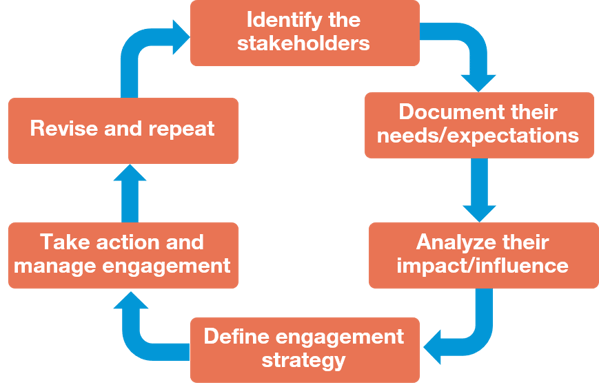Project Manager
Guide to effectively managing stakeholders
Project Manager
Updated on March 18, 2020.
These days, almost all digital projects happen in a context where stakeholders play a major role in getting tasks done. Projects are more and more susceptible to the actions and decisions of both internal and external stakeholders. Contributors to a project might include, for example:
- a project team,
- agencies,
- designers,
- programmers,
- directors,
- strategists,
- copywriters,
- media suppliers,
- clients,
- users,
- etc.
In a digital context, where everything moves quickly and where projects are often launched in a great hurry, we’ve noticed that managing stakeholders are sometimes forgotten about at the outset of a project, even though they are actually closely tied to the project’s success. Identifying and analyzing stakeholders are key to defining the requirements and expectations each group will have with regards to the project and related activities.
The challenge for digital project managers is also to ascertain the level of digital knowledge the project team has. The level of involvement required of a stakeholder can be difficult to determine if that resource has little experience in the world of digital. It’s up to the project manager to identify these challenges and make sure tools are put in place to manage the whole team’s understanding in order to establish the right balance between the reality of the project and the desired output.
In this article, I’ll explain four processes for managing stakeholders while managing a digital project that will help ensure you’re taking advantage of best practices to guarantee the success of your project.
Four stakeholder management processes
The 6th edition of PMBOK breaks this field of knowledge down into four processes:
- Identify the stakeholders
- Make a stakeholder management plan
- Manage stakeholder engagement
- Control stakeholder engagement
Identify the stakeholders
During this stage, you’ll need to identify every person, group or organization that might have an impact, either direct or indirect, on your project. You’ll have to think beyond internal stakeholders; it’s important to also include personas, users and consumers of your final product. User research can be a good way of taking the user into account in your decision-making process. Including your users’ opinions will allow you to take a more long-term vision of your strategy, rather than limiting yourself to the execution of the current project.
Next, it’s important to document and share information with all stakeholders and make sure that each of them is comfortable with the responsibilities that their role entails. Another way of working could be to let the team choose their own roles, then review for consistency.
The RACI model is a tool to help you identify the roles of each member of a project:
| LEVEL OF INVOLVEMENT | DESCRIPTION |
| Responsible for execution and follow-up | These people are responsible for executing or following the evolution of tasks, without necessarily being the decider. |
| Accountable/ultimate decider | The As are in charge of approval and validating actions; every project task needs their approval. |
| Consulted/provide advice if needed | These are generally experts with particular expertise on a certain subject. They are often called upon over the course of a project for advice. |
| Informed of the progress of the project/deliverable | These people need to be kept informed, even though they don’t have a deciding role in the project, because it’s possible changes will impact them. |
Making a stakeholder management plan
After identifying each person’s key roles, you’ll need to establish strategies to effectively manage the involvement of all identified stakeholders for the duration of the project. Depending on each person’s role, you’ll need to be able to make the relevant information available at the right time via a predetermined communication channel.

In your timeline, for example, you might plan meetings in advance, and identify who will be involved in each one. For example, the President might be an “I” (from the RACI model), because they wouldn’t necessarily be involved in the day-to-day advancement of the strategy for the website, but they would need to be kept informed at certain pivotal moments. Planning for the involvement of stakeholders throughout the timeline will prevent you from getting constant requests for information and progress, as well as requests for personalized updates, which reduce the efficiency of the project.
Managing and controlling the involvement of stakeholders
After completing the first two steps, we often sit back and say, “great, I’m done, I’ve identified my project’s stakeholders and came up with a plan.” Surprise! This task is iterative, so you’ll need to be constantly following up with stakeholders and remembering to update documents, and adapt your management strategies depending on what’s happening.
It’s also very important to promote an appropriate level of involvement in the project activities within the team, so that everyone has a chance to collaborate in the planning. Your task is therefore not only to make a plan, but to put in place and communicate your approach throughout the project.

In summary
The goal of managing stakeholders is to plan for and manage the expectations of all the contributors of a project and its end users, while reducing any negative impacts and improving the level of support offered. Depending on the scale of the project, it’s normal to expect that the time and scope of this activity might vary. However, I believe it’s important to take this on at the beginning of every project, and to talk about it with the project team. If you don’t take certain important stakeholders into account, the project could run into delays, extra costs, unforeseen issues, scope changes and even cancellation. You have the power to reduce these risks from the very beginning of your project.
What tools help you manage stakeholders?






